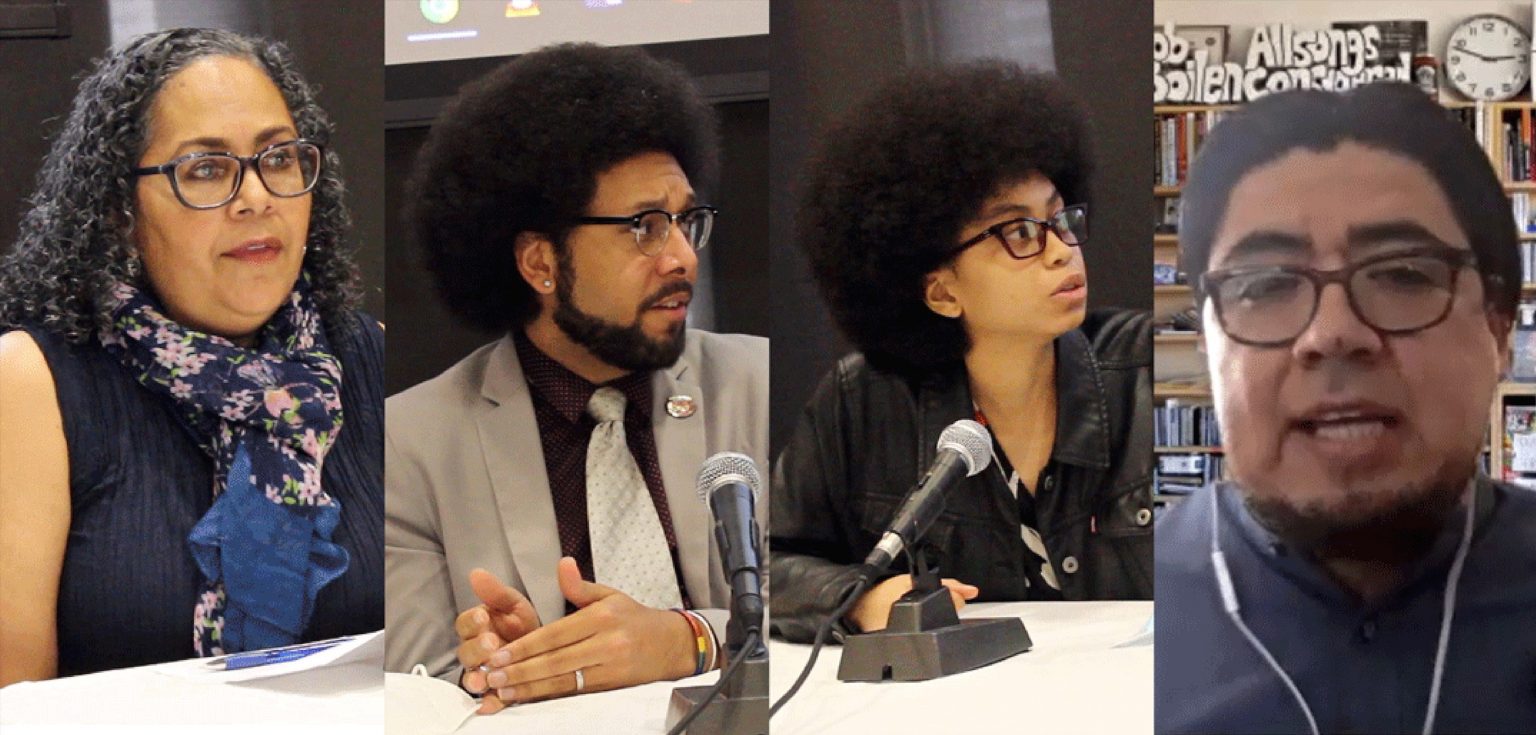In an Oct. 6 panel discussion, four members of the Fordham community explored this answer and the evolution of their own ethnic identities.
“We’re trying to fit a square into a round hole peg. We’re trying to find a word to name X amount of countries that have different cultures in a United States context,” said Juan Carlos Matos, assistant vice president for student affairs for diversity and inclusion, addressing an in-person audience and guests on Zoom at the Lincoln Center campus. “Folks sometimes get caught up in, well, what’s the right way? In many ways, we haven’t figured out the right way.”
Matos was joined by Tanya K. Hernández, Archibald R. Murray Professor of Law at the School of Law; Miguel García, Ph.D., assistant professor of Spanish at Fordham College at Rose Hill; and Bethany Fernández, a senior at Fordham College at Rose Hill and member of the Bronx COVID-19 Oral History Project.
The panel began with an overview of today’s Latinx population in the U.S. According to a recent study from the Pew Research Center, Hispanics now make up more than 60 million people in the U.S.—roughly 20% of the population, said the panel moderator and Fordham’s chief diversity officer, Rafael Zapata. But it’s still difficult to pinpoint a name that describes their collective identity.
“This has continued to evolve as American society figures out how to look at us and as we see ourselves and are changed by our migration, assimilation, integration, exclusion, and marginalization from the broader United States society and culture,” said Zapata, whose office co-hosted the panel with the Office of Multicultural Affairs.
No ‘Win-Win’ Situation
There are many different names to describe themselves, said the panelists. In 1980, the census started using the term “Hispanic”; a decade later, the term “Latino” began to become popular, said Zapata. The two terms, which refer to descendants of Spain and its former colonies in Central and South America and the Caribbean, continue to be used interchangeably. Other terms have sprung up since then, including “Latinx,” which was designed to be a gender nonconforming word.
But the term has received backlash because it is difficult to pronounce in Spanish and indigenous languages, said the panelists.
“When we’re dealing with what to call ourselves, we are navigating a very complicated question,” said Fernández. “If we try to define it in terms of English or Spanish, we are dealing with languages that have been involved in the colonization of our people. In that sense, there’s not really a win-win [situation]… If that’s how someone identifies and it makes sense and it’s not harmful to anyone else who is within our realm of Latinidad, that’s fine. Because ultimately, we want people to embrace who they are.”
Fernández, who identifies as Afro Latiné, said she was more familiar with her Black roots because of her mother, who introduced her to documentaries and museums focused on their culture. But she was able to bond with her Puerto Rican heritage on car drives with her father, where they often jammed out to their favorite salsa songs.
“He would enjoy the music and tap [the steering wheel]a little bit while we’re at the stoplight. But in those moments, while he was vibing, I was sitting down and listening to the songs and trying to figure out what they were saying, what songs I liked, and their message,” Fernández said.
Matos, who was born in the Dominican Republic and raised in Brooklyn, said he struggled to fully embrace his Afro-Latinidad heritage when he was younger. In elementary school, he said he felt ashamed of speaking Spanish after a classmate told him, “This is America—speak American.” His parents, a Black Dominican father and a fair-skinned, biracial mother, also disapproved of his afro.
“I definitely don’t think there was much acceptance of Blackness in my family, to this day,” Matos said.
Authenticity & ‘Complicating the Narrative’
What’s especially problematic is when people proclaim that they are Latinx, but are clearly not, said the panelists, citing the case of Jessica Krug, a white historian who pretended to be Black and Latina for years. García said that in one of his classes, his students discussed whether or not they should police people’s identities.
“They were very divided on the issue,” said García, who is Mexican American. “I am more interested in … What’s the political motivations that they are using to identify as Afro Latinx, Mexican American, Puerto Rican? Are they doing that to benefit themselves somehow?”
This year, the Census Bureau showed that the number of non-Hispanic Americans who identify as multiracial jumped by 127% over the past decade. But these results don’t really show a growth in the multiracial population, said Hernández. This increase in numbers is largely facilitated by people who, in light of George Floyd’s death and the Black Lives Matter movement, don’t want to be implicated in white supremacy, she said.
One stark example can be found in Puerto Rico, she said, where people’s selections for racial heritage drastically changed from 2010 to 2020.
“White alone went from 75% to 17%. Demographers will let you know that is not physically possible unless you’re talking about a mass genocide. The overall number of Puerto Ricans on the island has not changed, so this shift is one of social identity construction,” said Hernández,. “The fluctuation is less about an embrace of multiraciality and much more about a mad escape from any sense of implication in whiteness as a privilege.”
There is no checklist that defines someone as Latinx, said Matos. But if you start judging people by specific characteristics—like whether or not they speak Spanish or an indigenous language, said Matos—then you risk demoralizing people.
“I think it’s more about being authentic, being able to complicate the narrative, and us being open to that while checking people [like Jessica Krugg],” Matos said.

